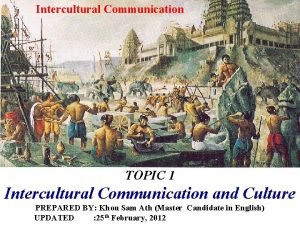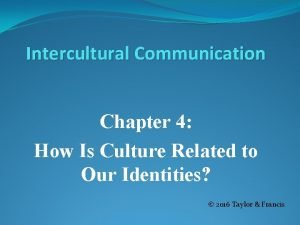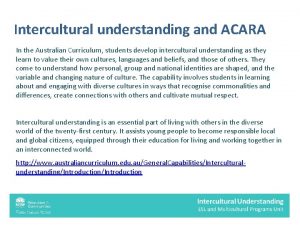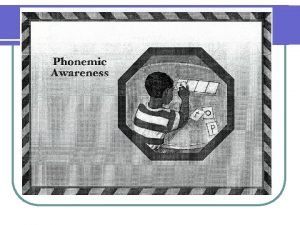Intercultural Awareness Course short version To raise your







































- Slides: 39


Intercultural Awareness Course (short version)

To raise your awareness of what culture is what guides the behaviour of cultural groups Why take this course? the complexity of your personal and social identities the beliefs you hold about your own and other cultures what cultural sensitivity is. To engage you in thinking how all these may influence your communication with others

This is a short version of the EURAXESS Intercultural Assistant Course. What is the course like? It takes you on a short journey to explore some aspects of culture and intercultural communication at your own pace. If you wish to go deeper into the subject, you can take the longer version of the course. Question time When you see this image, take a pause and think on the questions that follows it for a while and then go on.

A definition of culture a. the customary beliefs, social forms, and material traits of a racial, religious, or social group; also : the characteristic features of everyday existence (such as diversions or a way of life) shared by people in a place or time (i. e. popular culture; Southern culture) b. the set of shared attitudes, values, goals, and practices that characterises an institution or organisation c. the set of values, conventions, or social practices associated with a particular field, activity, or characteristic of society. Meriam-Webster Online Dictionary

Remember this? The Substance of Culture

These are the objective elements of a culture. Above the waterline You can see, hear, smell and touch them: food, dress, behaviour, architecture, folk music… They are the easiest to explain and the easiest to change.

These are the subjective elements of culture. Below the waterline We can judge about them on the basis of what we see: beliefs, thought patterns, notions of good or bad. . . We are often unaware of them and their role. Violating these “deep-down” conventions arouses deep emotions.

We judge about a culture only on the basis of its tip…

• What will make the greatest impression on a visitor to your own culture? Why? http: //www. ikea. bg/living-room/Sofas-and-armchairs/fabric- Question time sofas/Three-seat-sofas/ektorp-55703/59164914/ • Is this element the same in other places / organizations?

Culture and context

Every aspect of global communication is influenced by cultural differences. For example, industrialised nations rely heavily on electronic technology and emphasise written messages over oral or face-to-face communication. Examples: the United States, Canada, the UK, Germany… However, Japan, which has access to the latest technologies, still relies more on face-to-face communication than on the written mode. Goman: 2011

In some cultures, personal bonds and informal agreements are far more binding than any formal contract. In others, the meticulous wording of legal documents is viewed as most important. High-context cultures leave much of the message unspecified – to be understood through what is not said – in body language, in silences and pauses, and in relationships and empathy. Low-context cultures expect messages to be explicit and specific. They place emphasis on sending and receiving accurate messages directly, and being precise with spoken or written words. Goman 2011

• Examples of highcontext cultures: Mediterranean, Slav, Central European, Latin American, African, Arab, Asian, American-Indian • Examples of low-context cultures: Germanic, Englishspeaking ones

Time

In some cultures time is seen as a linear sequence. It’s important for things to happen according a schedule. Monochronic cultures: North American, English, German, Swedish, Dutch… In others, schedules are not that important. Time is less tangible and it is possible for many events to happen at the same time. Polychronic cultures: South American, Southern European, Asian Is time money across the globe?

Space “Contact” peoples (such as Southern Europeans, Asians and Arabs) maintain closer interpersonal spacing than “noncontact” peoples (such as the Americans and Northern Europeans).

Question time • What distance do you feel comfortable with when greeting people? • If other people’s being late is likely to make you experience negative emotions, how can you deal with it? • Do you prefer to talk to people in person or to send emails/text messages?

Erin Meyer’s Culture Map The Culture Map model is built on eight areas of cultural variations. This “map” is designed to help you understand where your own and other cultures are placed on these eight scales.

1. Communicating: Low-Context Versus High. Context If you are in a low-context culture, try to communicate directly and clearly. If you are in a highcontext culture, remember to pay attention to what is said “between the lines”. For example, the US are a lowcontext culture while Japan is at the other extreme.

2. Different cultures give and decode feedback in different ways. This does not depend on whether a culture is a low-context or a high-context one. When in France, expect to be given very direct feedback. If you are in the USA, locals would rather give you feedback in which critique is carefully intermingled with positive messages. Evaluating: Direct Negative Feedback Versus Indirect Negative Feedback

3. Persuading: Principles-First Versus Applications -First These two types of building your argumentation to persuade someone are again culturally bound. The principles-first type means providing the whole picture. The application-first type means outlining what has to be done in detail and later providing the background. In Western cultures, first explain what has to be done in concrete details. In Asian cultures, start with the background information.

4. Leading: Egalitarian Versus Hierarchical Cultures vary according to Power Distance, which also affects leadership, hierarchy and power. It is based on the dynamics of how an organisation distributes authority and what the relationship between bosses and workers are. If you are in an egalitarian culture (i. e. North American, Scandinavian), you can disagree with your superiors. If you are in a hierarchical one (i. e. Latin American), you have to act and communicate through the established appropriate channels.

5. Deciding: Consensual Versus Top-Down In most egalitarian cultures, expect consensual decision making. In most hierarchical cultures, expect top-downdecision making. However, this is not always the case. For example, the Japanese culture which is highly hierarchical, values consensual decision making.

6. In Germany and the Netherlands, expect “task-based trust”. This means that your confidence in someone else’s abilities to do a job or perform a task is created through having worked together. In China, Brazil or India, expect “relationship-based trust”. This means that your confidence in someone else’s abilities to do a job or perform a task comes from your affective relationship with a person you have socialised with. Trusting: Task-Based Versus Relationship-Based

7. Disagreeing: Confrontationa l Versus Avoids Confrontation The way we disagree and react to confrontation differs. In some cultures, it is believed that confrontation may have a positive effect. In others, there may be a complete avoidance of disputes and open disagreement. In France, people don’t find confrontation problematic. In Japan (like in most Asian cultures), confrontation is seen as harmful to harmony.

8. This scale again has to do with the monochromic-polychromic distinction above. If you are in a linear-time culture (such as Germany or the USA, expect people to stick to schedules and observe plans and deadlines. If you are in a flexible-time culture (such as Italy, Brazil or India), expect people to consider schedules changeable. Meyer: 2014 Scheduling: Linear-Time Versus Flexible-Time

Question time Imagine you don’t agree with your superior. Would you rather avoid expressing this openly? Think of a situation in which you have witnessed such confrontation. Was the result constructive or damaging to the work atmosphere? Why?

Who are you? This depends on • The roles you play in life: a daughter, a friend, a Ph. D student, a researcher, a member of EURAXESS staff • Your religion • Your birth place • Your current home place • Your ethnicity • Your gender • The things you like • The things you don’t like. . .

Question time Finish these sentences: • (People from my hosts culture) are… • (People from my own culture) are…

Identity is not only a question of how you Identity and intercultural communication perceive yourself. Others identify you, and you may not like the label they give you. You perceive reality through generalisations. However, this can lead to some negative consequences when communication across cultures.

Stereotypes Identity and intercultural communication They consist basically of shared beliefs or thoughts about a particular human group usually in terms of behavior, habits, etc. Their objective is to simplify reality: “they are like that”. They may be negative and positive – people often have positive stereotypes about their own cultural group.

Prejudices Identity and intercultural communication They are judgements you make about another person or other people without really knowing them. You learn them as part of your socialisation and they are very difficult to modify or do away with. Therefore, it is important to be aware that you have them. They can also be negative or positive.

Cultural adaptation

Stage Honeymoon What you feel Usually very positive feelings for the local people, the food, the surroundings, etc. Excitement, curiosity, willingness to immerse in the new culture Culture shock Psychological and physical disorientation Anxiety, frustration, even anger Fear and insecurity, homesickness You are overly sensitive to differences Adjustment Gradually the negative emotions are overcome Hopefulness and readiness to develop new patterns of life, more suited to the new surroundings Mastery A feeling of being comfortable in both your home and the new culture The stages of cultural adaptation

Question time • What can you do not to feel isolated or uncomfortable in a new culture? • What can you do to make others feel at ease in your own culture?

The following sources have been used to prepare the Intercultural Hall, Edward Twitchell. The Dance of Life: The Other Dimension of Time. Assistant website, self-test and self-access courses New York: Anchor, 1989. Hall, Edward Twitchell. Beyond Culture. New York, NY: Anchor Books, 2003. Bennett, Milton J. "A Developmental Approach to Training for Hofstede, Geert, and G. J Hofstede. Cultures and Organizations: Intercultural Sensitivity. " International Journal of Intercultural Relations 10, no. 2 (1986): 179 -96. doi: 10. 1016/0147 -1767(86)90005 -2. Software of the Mind. New York, NY: Mc. Graw-Hill, 2005. Hofstede, Geert. "Dimensionalizing Cultures: The Hofstede Model in Bennett, Milton J. Basic Concepts of Intercultural Communication: Paradigms, Principles, & Practices. London: Nicholas Brealey Publishing, Context. " Online Readings in Psychology and Culture 2, no. 1 (2011). doi: 10. 9707/2307 -0919. 1014. 2013. Karaasenova, Desislava. Cultural Dimensions of Academic Mobility. Ph. D Black, J. Stewart, and Mark Mendenhall. "The U-Curve Adjustment Hypothesis Revisited: A Review and Theoretical Framework. " Journal of Thesis. 2018. International Business Studies 22, no. 2 (1991): 225 -47. Meyer, Erin. The Culture Map: Breaking through the Invisible doi: 10. 1057/palgrave. jibs. 8490301. Boundaries of Global Business. New York: Public. Affairs, 2014. Brander, Pat. All Different, All Equal: Education Pack: Ideas, Resources, Methods and Activities for Informal Intercultural Education with Young Meyer, Erin. Navigating the Cultural Minefield. HBR. May 2014. https: //hbr. org/2014/05/navigating-the-cultural-minefield. Last access: People and Adults. Strasbourg: Council of Europe, 2004. 30. 03. 2018. Byram, Michael, Barrett, Martyn, Ipgrave, Julia, Jackson, Robert and Palaiologou, Nektaria. "Becoming Interculturally Competent through María del Carmen Méndez García Autobiography of Intercultural Encounters: Context, Concepts and Theories. Language Policy Division, Education and Training. " Intercultural Education 22, no. 2 (2011): 232 -33. doi: 10. 1080/14675986. 2011. 567083. Council of Europe Publishing, Strasbourg, France, 2008. Fellows, Richard, and Anita Liu. Research Methods for Construction. Samovar, Larry A. , Richard E. Porter, Edwin R. Mc. Daniel, and Carolyn S. Chichester, West Sussex, United Kingdom: John Wiley and Sons, 2015. Roy. Communication between Cultures. Boston, MA: Cengage Learning, 2017. Goman, Carol, K. How Culture Controls Communication. Forbes online. NOV 28, 2011. https: //www. forbes. com/sites/carolkinseygoman/2011/11/28/howculture-controls-communication/2/#63 b 32 d 566362. (Last access: 30. 03. 2018) Hall, Edward T. , and Mildred Reed. Hall. Hidden Differences, Studies in International Communication: How to Communicate with the Germans. Hamburg, W. Germany: Stern Magazine, 1983.


 Short short short long long long short short short
Short short short long long long short short short Syntactic awareness activities
Syntactic awareness activities Privacy awareness and hipaa awareness training cvs
Privacy awareness and hipaa awareness training cvs Your conscious awareness of your own name
Your conscious awareness of your own name Raise your right hand and repeat after me
Raise your right hand and repeat after me Raise your hand teams
Raise your hand teams Raise your love
Raise your love Raise your hand
Raise your hand Rf score
Rf score Jack in the beanstalk climax
Jack in the beanstalk climax Ptit safe driving and awareness course
Ptit safe driving and awareness course 13 malaysian safety goals
13 malaysian safety goals Basic electrical awareness course
Basic electrical awareness course In your notebook write questions about the people
In your notebook write questions about the people One brick t junction in english bond
One brick t junction in english bond Course number and title
Course number and title Course interne course externe
Course interne course externe Test your awareness whodunnit answers
Test your awareness whodunnit answers Give us your hungry your tired your poor
Give us your hungry your tired your poor Discrimination in intercultural communication
Discrimination in intercultural communication Stella ting toomey
Stella ting toomey Intercultural fluency
Intercultural fluency Intercultural conflict definition
Intercultural conflict definition Example of a low context culture
Example of a low context culture Intercultural communication questions
Intercultural communication questions Avowal and ascription
Avowal and ascription Intercultural communication youtube
Intercultural communication youtube Concepto interculturalidad
Concepto interculturalidad Intercultural miscommunication theory
Intercultural miscommunication theory Intercultural communication notes
Intercultural communication notes Kim's model of intercultural conflict
Kim's model of intercultural conflict Interculturally competent
Interculturally competent Staircase model of intercultural communication
Staircase model of intercultural communication Verbal intercultural communication examples
Verbal intercultural communication examples Intercultural personhood definition
Intercultural personhood definition Intercultural
Intercultural Nonverbal intercultural communication
Nonverbal intercultural communication Acara intercultural understanding
Acara intercultural understanding Intercultural development plan
Intercultural development plan Dmis stages
Dmis stages



























































